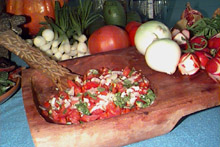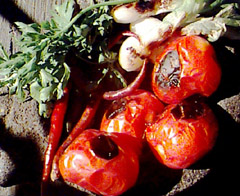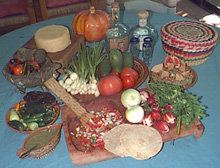salsa . (Latin salsa, salted.) fem. Composition or mixture of several edible substances, diluted, made to dress or season food.
There is no doubt that the above definition was translated from the Royal Spanish Academy Dictionary. Had it originated in Mexico, the definition would have a lot more flavor, color and gusto. Diluted, – a Mexican salsa? – Just for dressing and seasoning purposes?

Maestro Fuentes Mares used to say that wine is king on the table. Wine does not accompany food: you plan your menu according to the wine available. Something similar happens regarding Mexican salsas: it is around them that we build that earthly paradise known as Mexican cooking. A good mole, as any well-bred Mexican knows, possesses the virtue of transforming something so tasteless as white chicken breast into a real delicacy, worthy enough to be served on the most sophisticated and elegant table.
Salsa is a very significant expression ofculture. Since the dawn of time, we’ve been making efforts to improve our condition on this Earth; culture is one of the most extraordinary results of this age-old endeavor. In the same way we seek to dignify and elevate things from their rustic and wild status, to the limits set by our own imagination and resources. We cannot deny the fact that a good steak, properly grilled, has its virtues. But a well prepared sauce, with all those ingredients and hidden secrets, patiently and cleverly accumulated through generations, ennobles and redeems meats and fishes that otherwise would be almost completely worthless.
“Magic potion that adds excellency to almost everything that Nature presents in its original state, the sauce is so effective that it elevates the category of what is already good; corrects the insignificance of what is just mediocre, and hides the coarseness of what is bad”.
This quotation from don José Fuentes Mares defines in a very intelligent way the role of sauces in any civilized kitchen.
Learned people maintain that there are three great cuisines in the world: French, Chinese and Mexican. Anybody that experiments with this assertion soon discovers that it represents an over-simplification of reality:
- there are as many French cuisines as there are provinces in France;
- there is an extense variety of Chinese cuisines – Hunan, Szechuan, Fujian, Shandong, Anhui, Jiangsu, Beijing;
- and, of course, there is more than one Mexican cuisine. Excelling among the magnificent, are the marvelous cuisines from Puebla, Oaxaca and Yucatán.Nevertheless, a common denominator distinguishes these great cuisines from the others: the variety, complexity, magnificence, exquisiteness and refinement of their sauces.

salsa ingredient The Mexican salsa finds its support and foundation in the vigorous, spirited, vehement, but at the same time sensual and subtle flavors of the chile. The variety of chiles found in Mexico is amazing: poblano, serrano, pasilla, morita, manzana, güero – chilpotle, chipotle or chilpocle; chiltepín, piquín, mulato, chileancho, mirasol, chilaca, chilchote, cuaresmeño, jalapeño, habanero, tornachile, cora, de árbol, cascabel, and a thousand more. In different regions of Mexico, chiles get different names; and the same chile bears different names if it is dried or in its natural condition. A very popular, but erroneous belief, is that Mexican salsa, as it contains chile, must be unbearably hot. Nothing farther from the truth. A reasonably educated diner will never permit an excess of chile to saturate his or her taste buds and other sensory organs; a healthy balance between flavor and pungentness will always have to be attained in order to fully enjoy the delights offered by a well prepared salsa.
Basic ingredients of Mexican salsas are jitomate, or red tomato; onion, garlic, chiles, and cilantro, also known as coriander or Chinese parsley. Some salsas are based on little green tomatoes, tomatillos, or simply tomates, as they are named in Mexico. Many other elements may enter in the composition of a salsa, such as chocolate in the case of mole; seeds or nuts as sesame, pecan or almonds; and vinegar and lime juice.
Well, enough of philosophical treatises for now. Let’s see how to recreate some of these salsas we so much enjoy around here, and which are the heart and soul of meals and fiestas that you will never forget,
‘Aunque pasen y pasen los años…’
Even as the years go by.

salsa ingredients In Mexico, when we prepare ourselves to eat in a correct and educated way, como Dios manda, we first tone our stomach with a good shot of a very good tequila, the national apéritif par excellence.
After the ceremony of that first, appreciative shot, you can permit yourself to have some botanas, those preliminary snacks that are always present in every decent Mexican meal. We’ll keep it simple on this ocassion and only offer: tortillas, avocado, and white fresh cheese, with a very Mexican salsa. For the moment we may include in our gastronomical adventure, one of those excellent Mexican beers, served very cold, to wet our whistles.
SALSA MEXICANA
When the red tomatoes, ripe and sweet, intervene in this classic salsa, offered everywhere around the country, you have found the perfect accompaniment for your botanas. Please cut the ingredients by hand, never using electric help.
- 3 ripe tomatoes, chopped;
- 1/2 cup chopped onion;
- 1/2 cup fresh cilantro, chopped;
- 4 to 6 chiles verdes (chile serrano), finely chopped;
- 2 teaspoons salt;
- 2 teaspoons lemon juice.
Mix well all ingredients in a serving dish, or salsera. Add a little bit of water if needed. Salt to taste. You can, of course, make your salsa as hot as you want, by adjusting the amount of chile serrano you use.
At the beginning of your fiesta, you can arrange a table with serving plates offering avocado cut into slices, sliced white fresh cheese (what we call queso fresco or panela in Jalisco), tortillas kept warm in a tortillero, and the salsa; small individual dishes and napkins. Let your guests prepare their own tacos.
Remember that exposed avocado turns black in a short period. So cut it just before serving. To prolong its good looks, keep it in close contact with its seed. Sprinkling it with lemon juice helps.
After botanas and a couple of shots of tequila, we are ready to undertake more serious enterprises. Let the main course be served:
MOLE POBLANO DE GUAJOLOTE
They say this legendary recipe was created in Puebla in the XVII Century by Sister Andrea de la Asunción, a Dominic nun from Santa Rosa’s convent. The original concoction used nearly one hundred ingredients. Today, the mole is still the classic celebration meal, present at weddings, birthdays, baptisms and other fiestas. It is better to prepare the salsa in advance and then add the guajolote -turkey- on the big day. The reason for this is not only the lengthy and complicated procedure, but because it tastes better when the different aromas of the ingredients are given time to intermingle and combine.
To make the mole sauce -la salsa del mole- you should use a metate grinder, that heavy, flat stone present in every Mexican kitchen. Okay, okay, so you have a food processor. Anyway, the mole sauce must attain a smooth, even, thick consistency, without perceptible chunks of ingredients in it, but at the same time, not too fine. Hard to explain if you don’t have the original masterpiece in front of you. Well, then, use a metate!
- 1 guajolote (4 kg) cut in pieces
- 16 cups water
- 4 cloves garlic
- 1/2 yellow onion
- 1 tbsp salt
The Salsa:
- 1/2 cup plus 2 tbsp cooking oil
- 220 g chile ancho, deveined and seedless
- 90 g chile pasilla, deveined and seedless
- 315 g chile mulato, deveined and seedless
- 4 chiles chipotle
- 3/4 kg red tomatoes
- 1 onion, chopped
- 10 garlic cloves
- 150 g almonds, peeled
- 100 g peanuts, peeled
- 8 cloves
- 4 grains black pepper
- 1 twig cinnamon, about 4 cm in lenght
- 1/2 tsp anise seeds
- 90 g raisins
- 90 g sugarless confectionery cocoa (bitter chocolate)
- 1 tbsp sugar
- 2 tbsp salt, or to your liking
- 1/2 cup sesame seeds
Remember: 1 kg = 1 kilogram = 1,000 g = 1,000 grams = 2.2 lb
In a big cauldron, over high heat, place the turkey, water, garlic, onion and salt. When it starts to boil, cover and cook over medium heat for one hour, or until the guajolote is soft. Drain and reserve the broth.
To make the mole sauce, heat 2 tbsp oil in a heavy skillet and sauté for a couple of minutes, the chiles anchos, pasillas and mulatos. Then put the chiles in a bowl with hot water and let them stand for half an hour. Drain the chiles and grind them with your metate or whatever. Set aside, reserving the remaining oil in the skillet.
Roast chiles chipotle and tomatoes in a heavy skillet. In México we use a flat, round piece of steel or barro, called comal, for these operations. Peel tomatoes and pureé them with the chipotles. Reserve.
In the same oil you used for the chiles, sauté garlic and onion until translucent, remove from the oil and make a pureé out of them.
Sauté the almonds in the same oil for five minutes. Add peanuts, cloves, pepper, cinnamon and anise seeds, and sauté three more minutes. Grind this mixture along with the raisins.
Heat over high heat, 1/2 cup of cooking oil in a big casserole (I love my handy and beautiful cazuela de barro). Add all ground and pureéd ingredients and cook for five minutes, stirring constantly. Mix in the grated chocolate and sugar, stirring constantly. When the mixture boils, pour in 4 cups of the turkey broth you reserved. Cover and keep cooking over slow heat for 20 minutes. Add salt; check seasoning. If the sauce is too thick, add a little more broth.
Add turkey pieces, cover and cook over medium heat for another ten minutes. Meanwhile, roast the sesame seeds until golden, in your comal or heavy skillet. Serve the mole with sesame seeds sprinkled all over it. You may accompany it if you wish with Mexican rice and refried beans, and, of course, tortillas.
Serves 10 to 12.
Maybe my favorite salsa, to enjoy with grilled steaks and similar dishes, is molcajete salsa. The molcajete is that stone mortar, round and concave, supported by three short legs, in which, using another smaller and rounded stone, the tejolote, we crush and grind ingredients for many salsas. The word molcajete comes from the náhuatl words molli (salsa), and caxitl (cup). The molcajete and the metate are pre-Columbian instruments, rich inheritance from our American ancestors. Pieces we appreciate today in museums do not differ from those we use every day in our Mexican kitchens. Of course, you can prepare this salsa using one of those electric gadgets that profilerate and invade supposedly honourable kitches in this modern world. But it is not the same. No, it is not the same.
SALSA DE MOLCAJETE
- 5 chiles serranos, green
- 2 big red tomatoes, ripe
- 1 clove garlic
- 1 teaspoon salt
On a comal or heavy skillet, sautée chiles and tomatoes, about 10 minutes, or until they soften. Peel tomatoes.
On a molcajete or mortar crush chiles and garlic. When well mashed, add tomatoes and mash to perfection.
Add and check salt. Serve on the same molcajete.
This is all for the day. I’d just say now: ¡Buen provecho!
